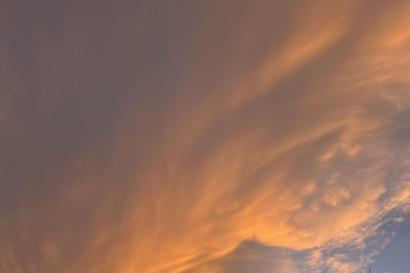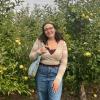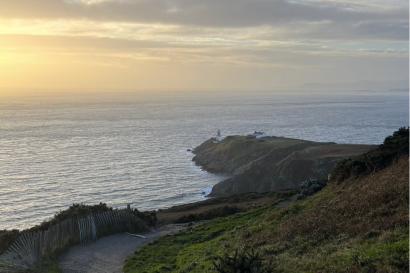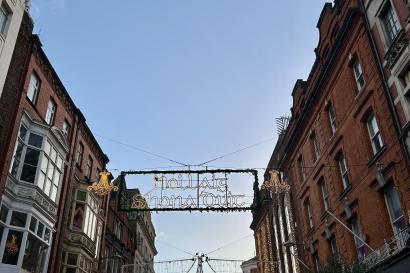If you were to ask what I was doing at this very second two years ago, "studying the poetry of Seamus Heaney" would be the right answer a good 95% of the time. I was a senior in high school, and amidst athletics and jobs and college applications, my peers and I spent nearly every moment of our free time flipping through our stacks of Heaney's poetry, each piece highlighted and annotated until the pages were covered in our pencil marks.
It's difficult to explain the International Baccaulareate program to anyone who hasn't been through it. In the simplest terms, our final scores for IB English were determined based on two external exams and three internal exams, one of which was the foreboding, intimidating, terrifying IOC. Short for "individual oral commentary," the IOCs consisted of drawing a random Heaney poem from those we studied, spending twenty minutes alone to prepare, and being called into a room with our teacher to deliver a ten-minute commentary while his computer recorded every word. Each IOC was conducted in a tiny church across the parking lot from our school. I don't remember anything about the walk besides the feeling that I was heading to my execution.
In hindsight, I'll admit I was a little dramatic. As nerve-wracking as the experience was, my IOC was over in less than an hour, and I left with the knowledge that I had worked hard to try and achieve a high exam score. I stuffed my packet of Heaney's poetry into my closet and told myself I would never look at it again.
But I didn't need the packet. I studied for other exams, graduated high school, and lost contact with many of my IB peers when I moved states to attend college, and all the while Heaney's work stayed with me. I started to take poetry more and more seriously, not realizing that I was subconsciously forming a writing style around what I admired from Heaney. When I arrived in Ireland just weeks ago, I caught myself repeating over and over that I studied Heaney in high school, and it struck me that his influence on Ireland extends far beyond anything I could ever describe. Within only a few days of my time here, I could no longer resist—I searched online and read Heaney's poems again for the first time since my senior year.
Alone in my bedroom, I was shocked to find that I was nearly in tears.
When the instructor of my Celtic Myth and Legend class told us we'd be going to Newgrange on a field trip, I didn't recognize the name at first. She began to explain that Newgrange is a Neolithic structure, the site of the largest passage tombs in Europe, and still the description didn't strike me as familiar.
But then she said there's a window at the front of the Newgrange mound. She said that each year on the winter solstice, the rising sun aligns precisely with the window and illuminates the entire tomb.
And suddenly I was back in IB English, in a small classroom of a small high school in Minnesota, living a vastly different life than I am right now. I remembered with shocking clarity the very lecture my English teacher gave about Newgrange and sites like it; I could picture the moment he switched the slide of his presentation and showed us photos of Newgrange, the window and stone walls and grass on top. In Seamus Heaney's Funeral Rites, he writes, "I would restore / the great chambers of Boyne, / prepare a sepulchre / under the cupmarked stones." The day we first read Funeral Rites was the day our teacher told us about Newgrange, about the many chambers of Boyne scattered through Ireland and how Newgrange is one of the few that truly has been restored.
After Celtic Myth class that day, I called my best friend from home, saying, "I don't know if you're going to remember this, but ..."
Of course she remembered.
On the field trip, I lifted my feet in steps of reverence. I breathed honor to the space, the tomb, the pieces of myself I've buried since high school and the pieces I've kept alive. I posted a picture on my Instagram story and wrote a brief message about Heaney and someone I know sent me a message, saying she was in IB English preparing for the IOC right that second and asking if she could show her teacher—our teacher—what I'd posted. A minute later, she told me I made his day.
It's been over two weeks since I went to Newgrange, over two weeks since I first tried to write this blog post. I still don't think I have the right words to describe the incredible beauty of it all.
Before studying abroad, everything I knew about Ireland came from a high school teacher, IB English, and Seamus Heaney.
I am eternally grateful for my past experiences. I am eternally grateful that I can continue to build upon them in the present.
My recommendations:
First, visit Newgrange. Let the darkness of the tomb envelop you and step back into the sun with a new understanding of what it means to be human, to be alive, to be lucky enough to see light and feel warmth on your skin.
Second, and more importantly, read Seamus Heaney. Read Blackberry Picking—the poem I drew for my IOC, in case you were curious—and The Grauballe Man and North. Read Punishment and The Badgers and Bog Queen. Read The Tollund Man. Read Mossbawn: Two Poems in Dedication. Read Viking Dublin: Trial Pieces.
Read Funeral Rites and imagine Heaney's pen, the people of the Neolithic ages, those that lived through the Troubles and those that didn't.
Imagine the chambers of Boyne, and try and try to restore them.

April Bannister
<p>I am a second-year student from Saint Paul, Minnesota, studying English and Creative Writing at the University of Iowa. I enjoy writing across all genres, especially within the focus of mental health, and I hope that my words can inspire education and awareness on the subject. Outside of school, I can often be found rock climbing, running, and spending time with my dog.</p>









